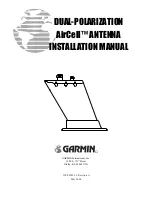
Loosen the screws/bolts of the mast clamp and
slide it onto the boom behind the reflectors.
Troubleshooting
No picture:
Check all the connections from aerial to TV.
Poor picture:
Check all the connections from aerial to TV.
Check aerial is properly aligned to the correct transmitter.
If the aerial has been loft mounted try mounting outside.
Make sure new digital coax cable has been used throughout
the installation.
Check the transmitter signal is not obstructed by nearby trees or
buildings.
If in a very weak signal area or for long cable runs,
installing a masthead amplifier will improve the signal.
If in a strong signal area the signal strength may need to be
reduced by fitting an attenuator.
© Philex Electronic Ltd. 2021 vb1.1
For further information, please contact:
Customer careline: 08457 573479 (
Local Rate - UK Only )
Technical Support: www.philex.com/support/
Specifications
Frequency Range MHz
470-694
TV Channels
21-48
Forward Gain dBi
13.5
Front/Back Ratio dB
>16
Beam Width +/-deg.
H32°/V40°
Connector
F-Type
Length
1100mm
Width
600mm
Other Useful Websites for Digital Advice:
*
To find out what DTT channels should be available locally and to
find out where your nearest transmitter is (distance and compass
bearing) visit: http://www.wolfbane.net/cgi-bin/tvd.exe
WEEE symbol. Waste electrical and electronic products should not be
disposed of with household waste. Please recycle where facilities exist.
Check with your Local Authority or local store for recycling advice.
yyWxx
Manufacturing date code: yy = year of production (21yy)
Wxx = week of production (01 to 52)
Additional technical information
UK Distributor
Philex Electronic Ltd.
Kingfisher Wharf, London Road,
Bedford MK42 0NX,
United Kingdom.
EU Distributor
Philex Electronic Ireland Ltd.
Robwyn House, Corrintra,
Castleblayney, Co. Monaghan,
A75 YX76, Ireland.
8mm
6mm
2mm
F
G
F. Thread the cable through
the weather boot
G. Fold the braid back over
the outer sheath*. Tear off
or cut away exposed foil.
Screw the F plug (I) on to
the cable. Trim inner wire,
leaving 2mm exposed.
*To prevent short circuits
ensure that no braid touches
the inner conductor.
Attach the assembled aerial
and clamp to the mast
D
E
Clamp
assembly
J
7. F Plug
3. Balun
H
Thread the cable through
the lower reflector
I
Attach the connector slide up
the boot to make a water tight
seal, attach cable to mast
Insulating Tape
Adjust the tilt and direction
of the mast clamp (5) to
tune for optimum reception.
For best results mount the aerial
on an outdoor aerial mast
pointed at the nearest
transmitter making sure it is in a
position where the transmitter
signal will not be obstructed by
nearby trees and buildings.
If you are unsure of the direction
the aerial should be pointing in,
or the orientation of the aerial
(horizontal for a main transmitter, vertical for a relay transmitter)
check your neighbours’ aerials. When adjusting the tilt angle
of the aerial, aim for horizontal or very slightly tilted upwards.
Tighten the nuts on the tilting mast bracket (7) when the
position is correct.
To help you align your aerial, ask someone to watch a con-
nected TV while you make adjustments.
You can also use a signal strength meter (not included) to
align your aerial for optimum reception.
5. Mast Clamp
Support: www.labgear.co.uk/support
1
Installation
For best results the aerial should be mounted on an outdoor aerial
mast and pointed in the direction of the nearest transmitter*
making sure it is in a position where the transmitter signal will not be
obstructed by nearby trees and buildings.
If you are in any doubt about the direction in which the aerial
should be pointing or the orientation of the aerial (horizontal
for main transmitter, vertical for relay transmitter) check your
neighbours’ aerials.




















